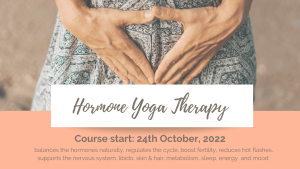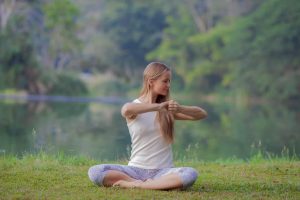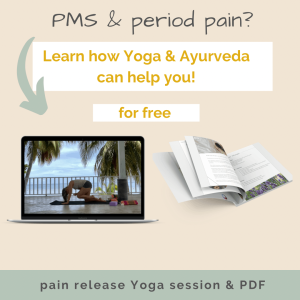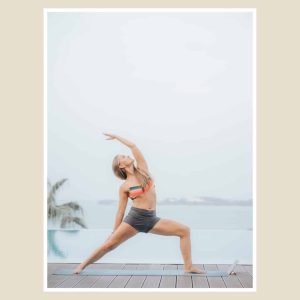Maybe it’s because I’m a yoga teacher myself, but over the past few years, I have met lots of people who have or are still considering yoga teacher training. To be more precise: people want to know if they should do a 200-hour course! Well – I can’t tell if someone should or shouldn’t do it, but I can share what to expect and my personal experience.
My way to a yoga teacher
My intention wasn’t to become a yoga teacher when I began travelling in Southeast Asia. Above all, I just wanted to explore, travel, and do some yoga. Secondly, I also had no idea how to become a teacher. So I went from one class to the next and, somehow, I found an advertisement about the program at “Shades of Yoga” in Bali. Firstly I had to fill out a form to apply for training. I actually thought that I’m not good enough yet to become a teacher and that they would never accept me for this 200-hour yoga teacher training.
After answering their questions, I wanted to find out how soon it started. I sent them the form, and two days later, I got an email saying that I had been accepted for the next course. At that time, I didn’t question it and booked everything around it, from accommodation to flights, etc.
That was around 5 years ago, and it is still one of the best decisions in my life.
My 4 weeks in Bali went by very quickly. The course was fun, challenging, and an amazing experience. I had to return to Germany afterwards, but so many things had changed in my life that I quit my job, returned to Bali, and then my real yoga journey started…
What a course looks like
But to come back to the course: naturally, I can only share my experience with you. A different school will provide a different schedule and content, which leads to a different experience. In these 4 weeks of training, we practised a lot of yoga asanas, but that was not all. The typical day started with a meditation at 7 am for around 30 minutes. After that we practised our asana (yoga postures) and pranayama (breathing techniques) until 9am and afterwards ate a delicious breakfast. From 10am until 12:30pm, it was time to study theory. In the course we learned about anatomy, yoga philosophy and teaching methodology.
At lunchtime, we had some free time and if needed, time to complete assignments (that’s like homework we had to hand in halfway through the course). In the afternoon, it was again time for more theory and practice. Every day was a little bit different, but we usually finished by 6pm. Generally, I went out for dinner or ordered in some food to eat in my little bungalow and started studying until around 9pm. It was a lot of new information, and there were many topics to review, study, or just to learn, such as Sanskrit. Sanskrit is the language used in yoga to name the yoga postures. You will also hear Sanskrit when going to a mantra chanting event.
By 9pm or 10pm at the latest, I was so tired and ready for a good night’s sleep. This went on from Monday until Saturday each week. Sunday was a day off which was much needed. During the last week of the course, we had our final exams, both theory and practical. Everyone had to teach a final yoga class and hand in all assignments. It was all very exciting and, after our final ceremony, we celebrated almost the whole night.
What I learned:
- that my body is very capable of doing things I didn’t know were possible,
- everything will pass, the good and the bad
- to accept myself the way I am
- that I can’t change the past, but I can live in the present moment
- to trust and to love others
- anatomical basics
- overview of the history of yoga
- the basics of chakras and meditation
- correct alignment in yoga
- …and so much more!
What to expect?
So, what should you expect? Be prepared to be physically and mentally challenged. Expect to dive deep and discover new things about yourself. Everyone is on their own journey, and I know many people for whom it was a life-changing experience.
Most importantly, you don’t need to be perfect in your yoga practice, but I do recommend you have some experience. Start your own practice and develop a routine. Make sure you’re in good and healthy condition, both physically and mentally.
Where to go for a YTTC?
Another big question: Where should you do the teacher training? Actually, it doesn’t matter which location you do it. Many people go to India, Bali, Thailand, or Sri Lanka – just to name a few. Above all, it is more important that you’re feeling good about the school and the teacher you choose. If possible, do a few classes with the headteacher of the school before you apply for the course. In case that’s not possible, check if they have classes on YouTube, for example, so that you can see if a specific style resonates with you.
What style to start with?
I would personally recommend starting with Hatha yoga teacher training. This will give you a broad overview and a great foundation. After that, you can decide if you want to delve deeper into a particular style. During the course, many people find out what they’re really drawn to and what their passion is. Maybe the Yin is calling you to slow down, or perhaps you want to go in the direction of Ashtanga, Kundalini or Vinyasa…you will find out!
Full-time or part-time?
Most schools offer the 200-hour course over four weeks, which is the perfect amount of time. You will also see ads for training in 21 or even 11(!!!) days. To clarify – anyone who can count should realise, that this is nearly impossible unless you want to practice 24/7. You need some time to let all this new knowledge sink in. In my course, a few people got sick during the first two weeks and missed out on a few classes. In the case you only had 11 days of training, it would be impossible to keep up with the workload.
Another option would be to do long-term training. I can’t speak from my own experience, but I know a few people who went down this route. Depending on the school, the lessons will be split into different modules over a few weekends, evening sessions, or weeks.
If you’re lucky enough to have 4 weeks available in a row, why not try doing it all in one run?!? You’re going to dive very deep into your practice. The courses with different modules spread over time are perfect for people who can’t stay away from their work or family for an extended amount of time.
YTTC at futurehippie
If you want to combine yoga teacher training with holidays, we would love to have you on one of our courses at futurehippie on beautiful Koh Samui, Thailand!
The next training course begins on March 23, 2020.
I hope that this gives you a bit of an overview of where and if you should enrol in a yoga teacher training program. Knowing you will learn a basic foundation can help you decide if you really want to start teaching yoga. It is a fantastic experience, and I highly recommend you do so.
For any other questions, just send me a message, and I’ll be happy to answer them.
Love & Light
Mika








